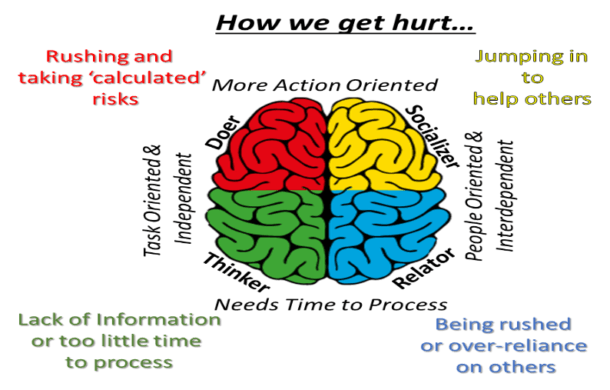Traditional safety, engineering, human factors, and human & organizational performance approaches do not effectively account for personality tendencies in a way that minimizes risk. From the oilfield to electric power generation and distribution, to construction and manufacturing, accounting for how individuals see and manage risk differently has been used to effectively reduce and mitigate risk, improve workforce engagement, and improve organizational safety culture.
For thousands of years, humans have known that we have different personality styles and tendencies. In ancient Asia, they used terms like “fire”, “wind”, “water”, “earth”, and others to describe people and the tendencies of their personalities. Even in your life today, if someone asks you if you know someone who has a “fiery” personality you can name them. The same could be said for someone who is “calm and cool as water.” It wasn’t until the early twentieth century that academics started to accumulate information and provide logical data-based theories behind the millennia of ‘anecdotal’ observations related to personalities.
Most of the personality typing mechanisms are good at predicting how we prefer to communicate, however, the data collected and analyzed over the last 10 years indicates some far deeper understandings. People with different personalities see and manage risk differently. Being aware of and managing our personality tendencies improves our ability to see and manage risk, and to communicate those risks to colleagues and the organization in a way that the risks are more effectively managed.
Most recent data from over 500,0000 data points show that through understanding our personality types and tendencies, we can also predict with great certainty the following elements related to safety and human and organizational performance:
- How and why people get hurt
- What makes it difficult to follow procedures, expectations, and guidelines
- What makes it difficult for people to stop work and seek out help
- How the human error traps impact us, and how they set those traps for ourselves and others.
Taking the lessons-learned by deploying in organizations around the world and by understanding these elements, organizations and individuals can better prepare to minimize the probability someone will make an error and be more predictive as to the appropriate mitigating factors needed when and if an error does occur. By providing individuals at all levels of the organization with specific tools for being aware of and managing the impact of our personality tendencies, we improve risk awareness, workforce engagement, communication and overall safety culture. You can discover your E-Colors and begin using this knowledge to help you see, manage and discuss risk differently by downloading the “E-Colors” app from the App Store or Google Play and taking the Personality Diversity Indicator (PDI). You can also visit www.error-reduction.com [Discover Your E-Colors].
Want another insight? CLICK HERE!

